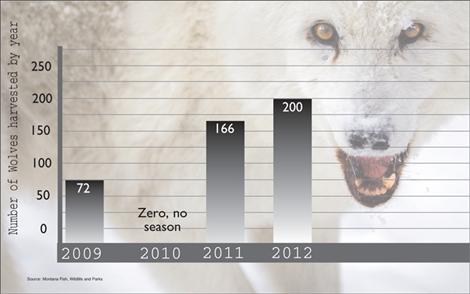Legislature expands wolf hunt
Hey savvy news reader! Thanks for choosing local.
You are now reading
1 of 3 free articles.
HELENA — Proving the wolf debate in Montana spans party lines, Montana legislators passed a bill that drastically changes Montana’s wolf hunt with nearly unanimous support in less than a week. Governor Bullock signed House Bill 73 into law Feb. 6.
House District 11 Rep. Greg Hertz said at least 10 bills regarding wolves were introduced to the legislature this session. Hertz had planned to introduce his own, but after seeing the volume of bills and making sure his ideas were included in HB 73, he decided not to.
“It’s obvious the wolf reintroduction in Montana had good intentions, but now it’s getting to where the population is too large and we need to do things to allow FWP to get a better handle on managing these wolves,” Hertz said.
The bill, sponsored by Rep. Kelly Flynn, R-Townsend, allows hunters to purchase up to three wolf tags and lowers the price of nonresident tags from $350 to $50.
According to a press release from Montana Fish, Wildlife and Parks, the bill also strengthens state wildlife officials’ efforts to manage a recovered and growing wolf population. Governor Bullock said the measure “leaves management of the gray wolf where it belongs, in the hands of scientists, not politicians.”
The new bill also allows hunters to take a wolf 24 hours after purchasing a tag instead of having to wait five days, authorizes the use of electronic calls, rescinds the requirement to wear hunter orange outside the general deer and elk seasons ands opens areas near national parks to wolf hunting. Even so, wildlife officials retain the ability to close these areas after wolf hunting quotas are met.
Hertz said he hopes HB 73 will help FWP and wildlife managers get a better handle on the wolf population. For example, the non-resident wolf tag price went down from $350 to $50 because “people just weren’t buying the tags; it was just too expensive.”
“We just have to continue to work with FWP and different policy makers on trying to control wolves. What we’ve been doing obviously hasn’t been working, so hopefully some of these changes will assist us,” he said. “Wolves reproduce at a very fast rate, so I think we’re just going to have to allow FWP to have some leeway and stay on top of some of these changes to manage the wolves.”
FWP communication and education director Ron Aasheim said this year’s harvest is going well and the introduction of a trapping season has increased numbers, but he’s still not sure whether this year’s harvest will influence whether the population increases, decreases or stays the same — there are just too many variables to be sure.
“We had worked with legislators before the session and they had expressed interest,” Aasheim said. “We knew (HB 73) was coming and we were very supportive .. it was a bipartisan expression across the board.”
Aasheim said FWP had worked with many special interest groups on the bill before it passed, including the Elk Foundation, Montana Sportsmens Alliance, Sportsmen for Fish and Wildlife, the Farm Bureau, the Wildlife Federation, many outfitters and guides as well as local sportsmen’s groups to help all parties come to a mutual understanding before the legislative session.
“First of all, the good news is that everybody in those groups has gotten over the fact that we need to fight wolves in Montana. They also agreed, unanimously, that you can’t have a predator near the top of the food chain that isn’t managed like the prey species it uses as a food source,” Aasheim said.
As big game numbers have diminished significantly as a result of wolf predation, and livestock are continually at risk, Aasheim said one of the tools used for managing wolves is hunting.
“That’s what the whole thing is about — letting the state manage (wolves) as they do other species,” he said.
At present, Aasheim said there is no talk of extending the hunt, and the commission tasked with making such decisions met Feb. 14 and no action was taken.
As of Feb. 15, 200 wolves had been harvested in the 2012-13 season, up from 166 last year. More than 80 were taken by wolf trappers. While reasonably pleased with these numbers, Aasheim reiterated that the population counts would not be available until March, when the final data from FWP is combined with the U.S. Fish and Wildlife Service.
“We’re up by 34 (harvested wolves) from last year,” he said. “Whether or not that’s a number that gets us in balance, probably not yet, but we don’t know what our minimum counts are yet ... there’s too many factors.”
Regardless of political or personal sentiments on the matter, Aasheim said the wolves are here to stay.
“It looks like it, and they’re certainly doing well,” he said. “They’re very good at adapting and reproducing and they are resilient. The state has a wolf management plan that says we intend to manage for a recovered population balanced with other wildlife and land owner tolerance and what the Endangered Species Act requires, so we retain management authority.”
The wolf commission will meet again in July to evaluate the previous year’s hunt and discuss the next harvest. Aasheim said the public will have “all kinds of opportunities” to comment on the matter, something they’ve not been shy about in the past.
When FWP sought to close hunting in two areas around Yellowstone Park this year because too many collared wolves were being taken, wildlife managers received more than 2,500 public comments on the matter.
“I think that should tell you that there’s some interest and some passion with this debate,” he said.
















